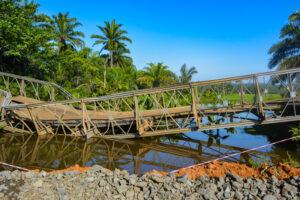A tragic iron bridge collapse at a popular tourist spot in western Maharashtra, India, claimed the lives of at least four people and left 38 others injured on June 15. This incident adds to a series of infrastructure failures in the region. The disaster occurred when the bridge gave way over the river, causing visitors to fall into the fast-moving waters below.
Emergency responders quickly arrived after the collapse, rushing to pull victims from the water and transporting the injured to nearby hospitals. Several ambulances and rescue teams were deployed as local authorities led efforts to manage the scene and treat the flood of casualties.
The bridge, made of iron and spanning the Indrayani River, was widely used by tourists. Heavy rainfall had caused the river to swell. Early assessments point toward structural failure as a likely cause, though official reports have not yet been released.
Photos before and after the collapse revealed warning notices that restricted the bridge’s use to just one two-wheeler and a handful of people at a time. Officials highlighted the bridge’s narrow width—just four feet across. Nonetheless, at the time of the accident, there were around seven or eight motorbikes and a sizeable crowd gathered on the bridge. Authorities estimated that over 100 people were on the structure, ignoring the posted warnings.
Only a few hours before the tragedy, a local resident warned police about overcrowding on the bridge around 12:30 p.m. Officers soon arrived and dispersed the group, but many—primarily tourists—returned shortly afterward to the popular crossing.
By approximately 3:15 p.m., the bridge began shaking for nearly five minutes before ultimately collapsing under the load.
Among the 42 total casualties, four individuals died after being rescued from the water and taken to local hospitals. Thirty-eight others were injured, with several transported to regional medical centers for urgent surgeries and specialized treatment.
Officials from Maharashtra noted that routine inspections of the bridge had been conducted, though a full review of its maintenance history will form part of the ongoing investigation. The tourist location regularly attracts hundreds of visitors per day, especially during peak seasons.
Eyewitnesses recounted hearing a loud cracking sound just before the bridge failed, sending people and debris plummeting into the river. Dozens were crossing when the structure gave way, contributing to the high casualty numbers. Emergency teams reported that some victims were trapped under collapsed sections and required significant rescue efforts.
In response, state authorities have ordered prompt inspections of similar iron bridges throughout Maharashtra, particularly those at tourist attractions. Engineers and safety officials will assess these bridges to ensure such an incident is not repeated.
Hospital sources reported that the injured suffered a range of trauma, including fractures, cuts, and internal injuries consistent with falling from significant heights. Medical staff worked throughout the day to stabilize the victims, with several needing advanced care.
The affected tourist site has been temporarily closed for safety inspections and cleanup efforts. Local tourism officials said the area would remain closed until all hazards are addressed and safe access could be provided.
Following the collapse, Maharashtra’s disaster management agency initiated emergency response protocols, coordinating closely with hospitals to ensure care for all victims. The state government announced financial aid for the families of those who died and pledged to cover medical costs for the injured.
Rescue teams continued to search for several hours after the incident, combing the river and nearby areas for additional victims. Divers inspected the water beneath the collapsed bridge, but no further casualties were found.
Local authorities set up a dedicated helpline to assist families seeking information about those involved. The helpline provided updates on patient status and hospital locations for relatives trying to find loved ones.
A dedicated engineering commission has been formed to investigate the technical reasons behind the bridge collapse, including examining the materials and construction methods. The commission is expected to deliver its report to state officials within 30 days.

